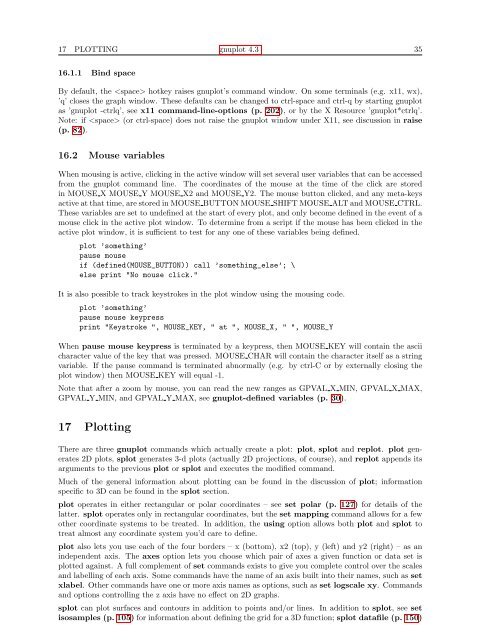gnuplot documentation
gnuplot documentation
gnuplot documentation
You also want an ePaper? Increase the reach of your titles
YUMPU automatically turns print PDFs into web optimized ePapers that Google loves.
17 PLOTTING <strong>gnuplot</strong> 4.3 35<br />
16.1.1 Bind space<br />
By default, the hotkey raises <strong>gnuplot</strong>’s command window. On some terminals (e.g. x11, wx),<br />
’q’ closes the graph window. These defaults can be changed to ctrl-space and ctrl-q by starting <strong>gnuplot</strong><br />
as ’<strong>gnuplot</strong> -ctrlq’, see x11 command-line-options (p. 202), or by the X Resource ’<strong>gnuplot</strong>*ctrlq’.<br />
Note: if (or ctrl-space) does not raise the <strong>gnuplot</strong> window under X11, see discussion in raise<br />
(p. 82).<br />
16.2 Mouse variables<br />
When mousing is active, clicking in the active window will set several user variables that can be accessed<br />
from the <strong>gnuplot</strong> command line. The coordinates of the mouse at the time of the click are stored<br />
in MOUSE X MOUSE Y MOUSE X2 and MOUSE Y2. The mouse button clicked, and any meta-keys<br />
active at that time, are stored in MOUSE BUTTON MOUSE SHIFT MOUSE ALT and MOUSE CTRL.<br />
These variables are set to undefined at the start of every plot, and only become defined in the event of a<br />
mouse click in the active plot window. To determine from a script if the mouse has been clicked in the<br />
active plot window, it is sufficient to test for any one of these variables being defined.<br />
plot ’something’<br />
pause mouse<br />
if (defined(MOUSE_BUTTON)) call ’something_else’; \<br />
else print "No mouse click."<br />
It is also possible to track keystrokes in the plot window using the mousing code.<br />
plot ’something’<br />
pause mouse keypress<br />
print "Keystroke ", MOUSE_KEY, " at ", MOUSE_X, " ", MOUSE_Y<br />
When pause mouse keypress is terminated by a keypress, then MOUSE KEY will contain the ascii<br />
character value of the key that was pressed. MOUSE CHAR will contain the character itself as a string<br />
variable. If the pause command is terminated abnormally (e.g. by ctrl-C or by externally closing the<br />
plot window) then MOUSE KEY will equal -1.<br />
Note that after a zoom by mouse, you can read the new ranges as GPVAL X MIN, GPVAL X MAX,<br />
GPVAL Y MIN, and GPVAL Y MAX, see <strong>gnuplot</strong>-defined variables (p. 30).<br />
17 Plotting<br />
There are three <strong>gnuplot</strong> commands which actually create a plot: plot, splot and replot. plot generates<br />
2D plots, splot generates 3-d plots (actually 2D projections, of course), and replot appends its<br />
arguments to the previous plot or splot and executes the modified command.<br />
Much of the general information about plotting can be found in the discussion of plot; information<br />
specific to 3D can be found in the splot section.<br />
plot operates in either rectangular or polar coordinates – see set polar (p. 127) for details of the<br />
latter. splot operates only in rectangular coordinates, but the set mapping command allows for a few<br />
other coordinate systems to be treated. In addition, the using option allows both plot and splot to<br />
treat almost any coordinate system you’d care to define.<br />
plot also lets you use each of the four borders – x (bottom), x2 (top), y (left) and y2 (right) – as an<br />
independent axis. The axes option lets you choose which pair of axes a given function or data set is<br />
plotted against. A full complement of set commands exists to give you complete control over the scales<br />
and labelling of each axis. Some commands have the name of an axis built into their names, such as set<br />
xlabel. Other commands have one or more axis names as options, such as set logscale xy. Commands<br />
and options controlling the z axis have no effect on 2D graphs.<br />
splot can plot surfaces and contours in addition to points and/or lines. In addition to splot, see set<br />
isosamples (p. 105) for information about defining the grid for a 3D function; splot datafile (p. 150)

















